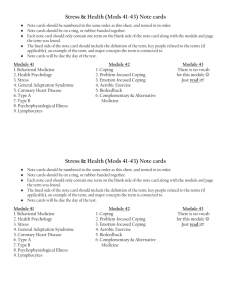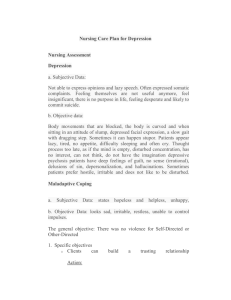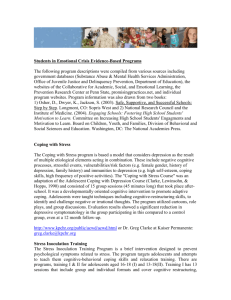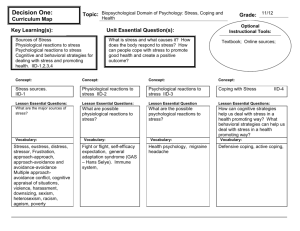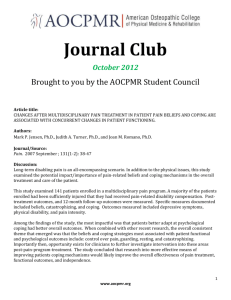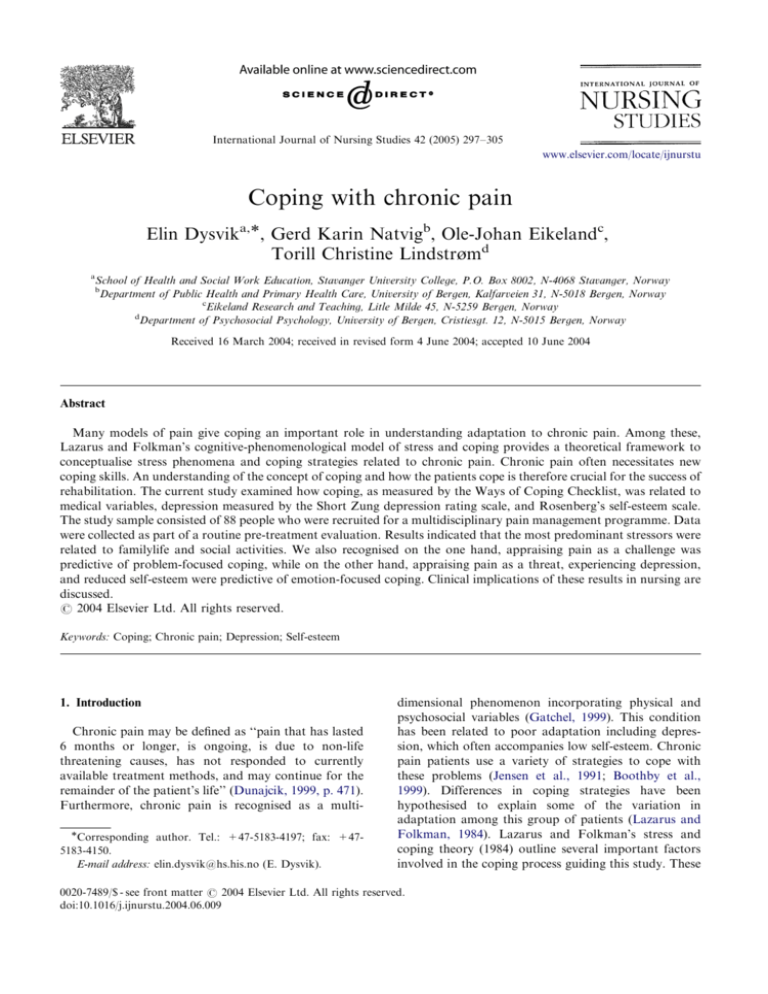
ARTICLE IN PRESS
International Journal of Nursing Studies 42 (2005) 297–305
www.elsevier.com/locate/ijnurstu
Coping with chronic pain
Elin Dysvika,, Gerd Karin Natvigb, Ole-Johan Eikelandc,
Torill Christine Lindstrømd
a
School of Health and Social Work Education, Stavanger University College, P.O. Box 8002, N-4068 Stavanger, Norway
Department of Public Health and Primary Health Care, University of Bergen, Kalfarveien 31, N-5018 Bergen, Norway
c
Eikeland Research and Teaching, Litle Milde 45, N-5259 Bergen, Norway
d
Department of Psychosocial Psychology, University of Bergen, Cristiesgt. 12, N-5015 Bergen, Norway
b
Received 16 March 2004; received in revised form 4 June 2004; accepted 10 June 2004
Abstract
Many models of pain give coping an important role in understanding adaptation to chronic pain. Among these,
Lazarus and Folkman’s cognitive-phenomenological model of stress and coping provides a theoretical framework to
conceptualise stress phenomena and coping strategies related to chronic pain. Chronic pain often necessitates new
coping skills. An understanding of the concept of coping and how the patients cope is therefore crucial for the success of
rehabilitation. The current study examined how coping, as measured by the Ways of Coping Checklist, was related to
medical variables, depression measured by the Short Zung depression rating scale, and Rosenberg’s self-esteem scale.
The study sample consisted of 88 people who were recruited for a multidisciplinary pain management programme. Data
were collected as part of a routine pre-treatment evaluation. Results indicated that the most predominant stressors were
related to familylife and social activities. We also recognised on the one hand, appraising pain as a challenge was
predictive of problem-focused coping, while on the other hand, appraising pain as a threat, experiencing depression,
and reduced self-esteem were predictive of emotion-focused coping. Clinical implications of these results in nursing are
discussed.
r 2004 Elsevier Ltd. All rights reserved.
Keywords: Coping; Chronic pain; Depression; Self-esteem
1. Introduction
Chronic pain may be defined as ‘‘pain that has lasted
6 months or longer, is ongoing, is due to non-life
threatening causes, has not responded to currently
available treatment methods, and may continue for the
remainder of the patient’s life’’ (Dunajcik, 1999, p. 471).
Furthermore, chronic pain is recognised as a multiCorresponding author. Tel.: +47-5183-4197; fax: +475183-4150.
E-mail address: elin.dysvik@hs.his.no (E. Dysvik).
dimensional phenomenon incorporating physical and
psychosocial variables (Gatchel, 1999). This condition
has been related to poor adaptation including depression, which often accompanies low self-esteem. Chronic
pain patients use a variety of strategies to cope with
these problems (Jensen et al., 1991; Boothby et al.,
1999). Differences in coping strategies have been
hypothesised to explain some of the variation in
adaptation among this group of patients (Lazarus and
Folkman, 1984). Lazarus and Folkman’s stress and
coping theory (1984) outline several important factors
involved in the coping process guiding this study. These
0020-7489/$ - see front matter r 2004 Elsevier Ltd. All rights reserved.
doi:10.1016/j.ijnurstu.2004.06.009
ARTICLE IN PRESS
298
E. Dysvik et al. / International Journal of Nursing Studies 42 (2005) 297–305
are the person’s stress experience, evaluation of
resources (appraisal) and his or her thoughts and
behaviour to manage the demands (coping).
2. Theoretical framework
Lazarus and Folkman (1984, p.19) define psychological stress as ‘‘a particular relationship between the
person and the environment that is appraised by the
person as exceeding his or her resources and endangering well-being’’. People with chronic pain must deal with
more than just the daily stress caused by their pain. In
addition to their medical problems, associations have
been reported between chronic pain and psychological
problems such as depression (Fishbain et al., 1997;
Brown et al., 2002) and low self-esteem (Williams and
Thorn, 1989; Davis, 2000). The pain-related problems
described above may be appraised as exceeding the
person’s resources (Lazarus and Folkman, 1984), and
contribute to the stress of a person with chronic pain.
In the broadest sense, coping among the participants in
this study means coping with these multiple stressors
(Boothby et al., 1999).
Cognitive appraisal determines the meaning of the
person–environment relationship and the person’s emotional response to chronic pain (Lazarus and Folkman,
1984). When the pain-related stressors are appraised as
exceeding the person’s resources, well-being is threatened. Appraising stress as a threat refers to the
potential for harm or loss and produces a negative
emotional response, which is closely related to vulnerability. On the other hand, appraising stress as a
challenge is a positive response, which focuses on
growth and mastery (Lazarus and Folkman, 1984). Pain
patients often have negative and maladaptive appraisals
about the situation and their own ability to control pain,
and thus tend to appraise their pain as a threat (Turk
and Flor, 1999) and rely on emotion-focused coping
(Smith and Wallston, 1992). As depression also tends to
influence appraisal, depressed people may appraise
threat more easily in demanding encounters. However,
results have demonstrated that cognitive restructuring
by encouraging more realistic appraisals may reduce
depression among chronic pain patients (Boothby et al.,
1999). Furthermore, appraising stress as a challenge
is seen to play a crucial role in reducing threat
and enhancing self-esteem as well as problem solving
(Bednar and Peterson, 1995).
Since the 1960s there has been a growing recognition
that while stress is an inevitable aspect of human life, it
is coping that is essential for adaptation. Although
definitions of coping have varied across time, the
conceptualisation most often used in nursing research
is the one proposed by Lazarus and Folkman (1984).
They define coping as ‘‘constantly changing cognitive
and behavioural efforts to manage specific external or
internal demands that are appraised as exceeding the
resources of the person’’ (Lazarus and Folkman, 1984,
p.141). Their coping concept is process-oriented rather
than trait-oriented as it reflects the idea that coping
efforts change according to situations and with time.
Coping serves two overriding functions. Emotionfocused coping (EFC) is considered as attempts to
control or minimise emotional distress caused by pain
when a situation is appraised as if nothing can be done.
Problem-focused coping (PFC), on the other hand,
refers to situations that are appraised to be amenable to
change. The efforts are directed at defining the problem
and choosing between alternative solutions. According
to Lazarus (1999) both forms of coping occur in nearly
all stressful encounters. However, with respect to
chronic pain, problem-focused strategies should presumably reduce stress and result in greater well-being in
situations that are amenable to change, whereas emotion-focused strategies should give a more positive result
in situations considered as unchangeable (Lazarus,
1999).
Lazarus (1999) discusses the relation between coping
and health and states that whether the coping strategies
will have health promoting consequences or not,
depends on the special situation in which they are
applied. However, some conclusions can be drawn from
research that have related coping to physical and
psychological well-being following stressful encounters.
Reviews concerning chronic pain have shown that active
coping (e.g., problem-focused coping) tended to be
associated with better physical and psychological
functioning, whereas the use of passive coping
(e.g., emotion-focused coping) was associated with poor
physical and psychological functioning (Jensen et al.,
1991; Boothby et al., 1999). Furthermore, patients
who used emotion-focused coping had more difficulty
adapting to chronic disease than those who used
problem-focused strategies (Bombardier et al., 1990;
Maes et al., 1996). Associations have also been reported between depression and emotion-focused coping
strategies in chronic pain (Weickgenant et al., 1993; de
Ridder and Schreurs, 2001; Endler et al., 2003). In
addition, individuals with high self-esteem seem to
rely more on problem-focused coping (Terry, 1994)
and are less depressed (Bednar and Peterson, 1997;
Mruk, 1999).
As coping and appraisal are considered important
mediating variables between the person–environment
relationship and adaptation, the findings suggest the
importance of targeting these variables to increase
knowledge of the choices chronic pain patients make
in stressful encounters. Since coping in chronic pain is
also related to depression and reduced self-esteem, these
factors are recommended as a routine procedure in
clinical assessment (Lisanti, 1989; DeGood, 2000).
ARTICLE IN PRESS
E. Dysvik et al. / International Journal of Nursing Studies 42 (2005) 297–305
299
3. Method
3.3. Characteristics of participants
3.1. Aims of the study
Sociodemographic and medical data for the patients
are described in Table 1.
Based on coping theory and previous research, the
aims of this study were to:
(1) examine the main stressors among people suffering
from chronic pain;
(2) examine the role of medical variables such as pain
intensity, pain duration; and psychological variables
such as appraisals, depression and self-esteem in the
prediction of coping among people suffering from
chronic pain;
(3) discuss the importance of assessing coping in the
context of rehabilitation.
3.2. Recruitment procedure
The study sample consisted of 88 outpatients with
chronic pain, who were consecutive referrals to a
multidisciplinary pain management programme based
on a group approach. Data were collected as the first
part of a routine pre-treatment evaluation. Although
this was not a random sample, it was considered to
represent the different counties in Norway as the
Norwegian society is a rather homogeneous society.
The subjects met the following inclusion criteria:
Aged between 18 and 67.
Chronic non-malignant pain lasting for more than 6
months.
Medical investigation and/or treatment completed
prior to referral.
Motivation to participate in an active rehabilitation
programme.
No ongoing litigation due to their pain problem.
Exclusion criteria:
Affected by major mental disorders.
Affected by major medical conditions
requiring
treatment.
Prior to inclusion, all patients had undergone a
medical evaluation. They also met for a clinical interview with one of the group leaders from the multidisciplinary pain management programme, who
presented the programme and outlined the expectations
and obligations. Additionally, written instructions were
delivered. It was emphasised that voluntary participation was required and that the participants could leave
the programme at any time. Confidentiality was
guaranteed and a written consent form was obtained
at inclusion. The study was approved by the Regional
Ethical Committee and The Data Inspectorate, and was
conducted in accordance with the Helsinki Declaration.
3.4. Measures
The Ways of Coping Checklist (WCCL) is a measure
to operationalise and quantify coping and determine the
relation between stress, appraisal, coping strategies and
adaptation. It is derived from Lazarus and Folkman’s
transactional model of stress and coping (1984) and a
revised scale (WCCL-R) (Vitaliano et al., 1985) consisting of 42 items was administered. WCCL-R consists of
one scale labelled Problem-focused coping (PFC), three
scales of Emotion-focused coping (EFC) labelled Wishful thinking (WT), Self-blame (SB) and Avoidance (A)
and one scale labelled Social support (SS). The
respondents were asked to respond to these coping
items on a 4-point Likert scale with respect to the major
Table 1
Sociodemographic and medical data (N=88)
N
%
Age
46 (range: 22–66)
Sex
Female
Male
73
15
83
17
Marital status
Married/cohabitant
Widow/single
67
21
76
24
27
34
31
39
27
30
18
21
28
21
20
24
32
24
Education
Compulsory school
Upper secondary
school
College/University
Working status
Full/part-time
Retraining
Disability/retired
Sick leave/not at
work
Pain
Durationa
22 (of
total life)
Intensity
Pain diagnosis
Musculoskeletal
Headaches
Pelvic/visceral
Neuropathic pain
Whiplash
a
Mean
10 (range: 1–46)
67 (range: 19–100)
50
14
12
6
6
57
16
13
7
7
Average time since pain diagnosis.
ARTICLE IN PRESS
300
E. Dysvik et al. / International Journal of Nursing Studies 42 (2005) 297–305
stressor last week. High scores indicate more use of the
actual coping strategy. Two primary appraisal items
determined the meaning of the stressor in terms of
threat and challenge (Vitaliano et al., 1987). In this
study internal consistency (Cronbach’s alpha) of
WCCL-R suggests that this instrument possessed
satisfactory reliability estimates (PFC=0.83, EFC
=0.83, SS=0.85).
Short Zung depression rating scale (ZDS). The ZDS
scale (Tucker et al., 1987) has 10 items assessing the
severity of psychological and physiological manifestations of depressive symptomatology. Respondents describe how frequently they experience each symptom on
a 4-point Likert scale ranging from ‘‘seldom or never’’ to
‘‘most of the time’’. The instrument has proved to be a
useful brief screening test for depression and changes in
mood. ZDS is standardised according to Tucker et al.
(1987), and the standardised index identifies depressed
persons by those obtaining scores above 70. In this
group 35% scored above this limit. The scale had a
Cronbach’s alpha reliability coefficient of 0.85.
Rosenberg self-esteem scale (RSES). Self-esteem as
measured by the RSES (Rosenberg, 1965) consists of a
10 statements on a 4-point Likert scale and refers to an
individual’s thoughts and feelings with reference to self
as an object. The translation process involved three
phases: translation, back-translation and consensual
(Frank-Stromborg and Olsen, 1997). The RSES
has the advantage of easy administration and satisfactory scalability. The scale provides a single scale score
of self-esteem with higher scores indicating poorer
self-esteem. Cronbach’s alpha reliability coefficient
was 0.85.
The Visual analogue scales (VAS) (Huskisson, 1983)
is a 100 mm line that was used to measure pain intensity.
One end is defined as ‘‘no pain’’ and the other as ‘‘severe
pain’’. The patient is asked to mark the line at a point
corresponding to the present severity of the pain
experience. Particular advantages of the VAS are its
sensitivity, simplicity, reproducibility and universality
(Huskisson, 1983).
Pain duration was measured by one single item asking
for the year of diagnosis related to their pain problem.
3.5. Statistical analyses
Descriptive statistics were performed to gain knowledge of the characteristics of the sample. Raw scores
were calculated for each of the sub-scales in WCCL-R
and the different dimensions capturing EFC were
combined according to current recommendations (Vitaliano et al., 1990). Pearson bivariate correlation
coefficients were performed between the independent
variables (sociodemographic variables, medical variables, appraisal variables, depression and self-esteem)
used in the regression analyses. Lastly, hierarchical
regression analyses, predicting PFC and EFC from
sociodemographic variables, medical variables, appraisal, depression and self-esteem were performed in four
steps. Multicollinearity was not considered a problem in
these analyses as the highest VIF indicated 2.4 (emotionfocused coping) and 2.3 (problem-focused coping) and
the tolerance estimates showed acceptable levels (i.e.,
above 0.42). The statistical analyses were conducted
using the Statistical Package for the Social Sciences
(SPSS), version 10.
4. Results
4.1. Descriptive analyses
The respondents’ major stressors last week, as
measured by WCCL-R, were related to their own health
(38%), to family or social situation (53%) or work/
studies (9%).
4.2. Correlation analyses
The correlations were characterised as modest to high,
showing that challenge appraisal was negatively correlated with pain duration (r ¼ 0:22, po0:05). Depression was significantly correlated with pain intensity
(r ¼ 0:27, po0:05) and threat appraisal (r ¼ 0:46,
po0:05). Lastly, self-esteem was positively correlated with threat appraisals (r ¼ 0:35, po0:05) and
depression (r ¼ 0:69, po:05). The results are presented
in Table 2.
4.3. Hierarchical regression analyses
Hierarchical regression analyses, predicting PFC and
EFC from pain intensity, pain duration, appraisal,
depression and self-esteem are presented in Tables 3a
and b. The analyses were performed in four steps, first
by entering sociodemographic variables, then medical
variables, following appraisal variables. Lastly, depression and self-esteem were entered in the equation.
However, none of the variables produced significant
effects on the two dependent variables in the two first
steps. In step three, the change in the coefficients of
determination was significant concerning both PFC
(total R2=0.23) and EFC (total R2=0.49). Adding the
variables in step four increased the coefficient of
determination to 0.60 in the analysis of EFC, while no
significant contributions are seen in PFC at this step.
After the last step, challenge appraisal was the only
variable significantly associated with PFC, while the
measure of threat appraisal, depression and self-esteem
gave significant contribution to EFC.
ARTICLE IN PRESS
E. Dysvik et al. / International Journal of Nursing Studies 42 (2005) 297–305
301
Table 2
Pearson bivariate correlation coefficients between independent variables used in the regression analyses (N=88)
1.
2.
3.
4.
5.
6.
7.
8.
9.
10.
a
Age
Education
Gender
Marital status
Pain intensity
Pain duration
Threat
Challenge
Depression
Self-esteem
1
2
3
4
5
6
7
8
9
10
—
0.16
0.14
0.05
0.19
0.03
0.08
0.05
1.10
0.07
—
0.16
0.09
0.10
0.25a
0.00
0.07
0.06
0.07
—
0.11
0.05
0.20
0.06
0.14
0.08
0.22
—
0.13
0.02
0.04
0.10
0.32a
0.25a
—
0.18
0.16
0.13
0.27a
0.04
—
0.07
0.22a
0.12
0.01
—
0.07
0.46a
0.35a
—
0.02
0.15
—
0.69a
—
po0.05 (two-tailed). Pain duration=% of life with a pain diagnosis.
Table 3
Regression analyses
(a) of problem-focused coping (OLS, method enter) in four steps
Step 1: Sociodemographic variables
Age
Education (0=low)
Gender (0=male)
Marital status (0=single/wid.)
Step 2: Medical variables
Pain intensity (VAS)
Pain duration (% of life)
Step 3: Appraisal variables
Threat
Challenge
Step 4: Self-esteem and depression
Depression
Self-esteem
Constant
Total R2
R2 change
F/po
0.015
0.015
0.31/ns
0.078
0.230
0.254
0.063
0.152
0.024
b
Beta
po
0.00
0.08
0.01
0.11
0.04
0.08
0.01
0.09
0.75
0.49
0.94
0.40
0.00
0.00
0.18
0.08
0.12
0.44
0.02
0.18
0.06
0.44
0.01
0.02
0.08
0.16
0.22
—
0.32
0.13
0.86
0.00
0.05
0.18
0.00
0.01
0.05
0.15
0.00
0.93
0.55
0.08
0.99
0.00
0.03
0.00
0.06
0.99
0.50
0.16
0.05
0.46
0.12
0.001
0.13
0.01
0.02
0.59
0.23
0.21
—
2.77/ns
7.80/.01
0.63
0.001
1.24/ns
(b) of emotion-focused coping (OLS, method enter) in four steps
Step 1: Socio demographic variables
Age
Education (0=low)
Gender (0=male)
Marital status (0=single/wid.)
Step 2: Medical variables
Pain intensity (VAS)
Pain duration (% of life)
Step 3: Appraisal variables
Threat
Challenge
Step 4: Self-esteem and depression
Depression
Self-esteem
Constant
0.051
0.088
0.494
0.600
0.051
0.037
0.406
0.106
0.12/ns
1.63/ns
31.7/.001
10.4/.001
0.05
0.05
0.08
Note. All regression coefficients (unstandardised (b) and standardised (Beta)) after step four. Two-tailed level of significance (p).
Multiple R2; F-values of change in R2 at each step.
ARTICLE IN PRESS
302
E. Dysvik et al. / International Journal of Nursing Studies 42 (2005) 297–305
5. Discussion
In this study Lazarus and Folkman’s stress and
coping model (1984) was applied to the field of chronic
pain to reveal patterns of appraisals and coping in
stressful encounters. In addition to the burden of
chronic pain, several stressors, which interrupt daily life
in different ways, are reported (Turner et al., 1987). Our
results indicate that only 38% of the sample identified
their main stressor to be related to their own health,
whereas 53% related their main stressor to familylife
and social activities. Possibly, the stressors selected
among the participants occurred because WCCL-R
focuses on the main stressor last week and therefore
incorporate other stressors besides pain (Lazarus and
Folkman, 1984). Furthermore, phenomena such as
coping and pain tend to have multiple determinants
(Polit, 1996). Other explanations could be that medical
factors initiating the pain problem play a minor role
over time and several psychosocial problems become the
primary stressors and the patient’s main concern
(Turner et al., 1987). Our results suggest the importance
of examining non-pain stressors in chronic pain, which
have implications for rehabilitation.
Although correlations between the use of coping
strategies and measures of pain experience have been
reported in the literature (Jensen et al., 1991), no
relationship was found in this study. However, this
study has found that an appraisal of a stressful
encounter as a challenge was related to problem-focused
coping, whereas the experience of a stressful situation as
a threat was related to emotion-focused coping. The
differentiation between the two main types of appraisals
serves the perspective that challenge appraisals tend to
be superior to threat appraisals in chronic pain patients
(Lazarus and Folkman, 1984). Thus, our results
emphasise that two possible situational meanings is
related to the stressful situation, which have an influence
on coping. As reported, living with pain represents
several stressors related to the social life of the
participants. These stressors are often considered a
threat to well-being and have negative emotional
consequences (Smith and Wallston, 1992). Conversely,
evaluating the situation as a challenge tends to produce
a positive affect and the mobilisation of available
resources among the participants (Smith and Wallston,
1992).
It follows that the main goal in rehabilitation must be
to convert appraisals of threat realistically to appraisals
of challenge, as this seems to stimulate active participation and problem-solving. Appraisal training is suggested, which focuses on learning how to distinguish
between global and specific stressful situations as well as
unchangeable and changeable aspects (Folkman et al.,
1991). Other important strategies to cope successfully
with threat are suggested, such as personal responsibility
and willingness to face personal issues realistically
(Bednar and Peterson, 1995). Furthermore, success in
rehabilitation is said to depend on appraising the
situation in a new way and seeking a good fit between
appraisal and coping (Folkman et al., 1991). To improve
our understanding of coping with chronic pain, appraisals of stressful situations should be given more careful
consideration in the coping process (de Ridder and
Schreurs, 2001).
Different stressors appraised by people with chronic
pain influence coping in different ways. Participants
scoring high on depression in this study tended to use
more emotion-focused coping. This result is not
surprising as depression is primarily an emotional
disorder and will increase the likelihood to engage in
more emotion-related strategies. In support of this,
depression has been positively correlated with emotionfocused strategies (Weickgenant et al., 1993; de Ridder
and Schreurs, 2001; Endler et al., 2003) and reduced selfesteem (Mruk, 1999; Davis, 2000), which reflect the fact
that many of the stressful encounters are considered
negatively and not amenable to change. Such a coping
pattern could also be related to a decrease in problemfocused coping among the participants in this study,
which may further complicate effective rehabilitation.
Our results are consistent with previous research and the
theoretical differentiation between the two main types of
coping, and provide a perspective for emotion-focused
strategies to be more related to dysfunction (Jensen
et al., 1991; Boothby et al., 1999) and difficulty in
adaptation (Maes et al., 1996). On the other hand,
problem-focused coping is considered to be superior in
chronic pain patients and refers to active participation
and problem solving in rehabilitation (Jensen et al.,
1991; Boothby et al., 1999) and less depression (Endler
et al., 2003). In light of our findings, the provision of
information and counselling are suggested to help the
patients consider depression as a common state in
chronic pain and that emotions and behaviour constantly influence pain as well as coping. Teaching
relaxation training has demonstrated appropriateness
in reducing emotional stress and pain and is suggested as
additional treatment (Hawthorn and Redmond, 1998;
Davis, 2000). Additionally, offering training in cognitive
restructuring has been shown to be effective for
decreasing depression and improving problem-focused
coping (Boothby et al., 1999). However, a key factor in
coping effectiveness is to choose strategies, which fit the
possibilities in the situation and positively change the
person–nvironment relationship for the better (Folkman
et al., 1991; Lazarus, 1999).
The patients in our study who reflected low selfesteem tended to engage more in emotion-focused
coping. Although the adaptive utility of any specific
form of coping is context specific, we propose that such
a result is attributed to the fact that low levels of
ARTICLE IN PRESS
E. Dysvik et al. / International Journal of Nursing Studies 42 (2005) 297–305
self-esteem is likely to predispose feelings of vulnerability. Furthermore, less capacity for problem-solving
as well as desire to participate in rehabilitation may be
present. In contrast, other findings reflect that people
with high self-esteem rely more on problem-focused
coping (Terry, 1994), are less depressed, and have shown
a more positive adjustment (Bednar and Peterson, 1995;
Mruk, 1999). Self-esteem is considered an important
personal resource for coping (Lazarus and Folkman,
1984) and good starting point when trying to improve
coping (de Ridder and Schreurs, 2001). Therefore, selfesteem enhancement programmes should be offered,
which include the idea that a positive self-esteem
promotes more effective coping. Group approaches are
commonly described as beneficial as they focus on
problem-solving and social factors affecting self-esteem,
such as positive feedback and acceptance (Mruk, 1999).
Additionally, personal responsibility of self-care needs
and balancing self-esteem with a health alteration
should be included to obtain optimal adaptation (Miller,
2000).
5.1. The role of the nurse in pain management
Medical treatment for chronic pain is often unsatisfactory (Dunajcik, 1999). For health care professionals,
finding a treatment for people with chronic pain is seen
as a challenge because these patients do not fit the
traditional cause and cure model of medicine. There is a
general consensus that biomedical factors contribute
only modestly to disability (Turk and Flor, 1999).
Consequently, this allows for identification of the
various psychosocial factors influencing chronic pain
and coping. The multidimensional nature of chronic
pain means that it is unlikely that pharmacological
interventions are appropriate in all situations (Hawthorn and Redmond, 1998). Unfortunately, the patients
may have poor understanding about self-management
skills (Dunajcik, 1999), and may need help in finding
appropriate ways of coping in painful situations.
According to Dunajcik (1999) a rehabilitative focus
with active patient participation and a multidisciplinary
team approach is needed where professional nurses are
significant members. Several therapies commonly used
within such approaches are directly within the domain
of nursing, such as education, cognitive restructuring,
relaxation and distraction (Hawthorn and Redmond,
1998; Davis, 2000). Even though nurses draw on
psychological and behavioural medical views, clinical
nursing practice offers a caring perspective on chronic
pain and coping that is distinctively different from these
disciplines. Especially, the holistic perspective and
focusing on problem solving, communication and selfmanagement are said to play a vital role in pain care
(Hawthorn and Redmond, 1998; Davis, 2000). According to Hawthorn and Redmond (1998, p. 120) ‘‘the goal
303
of care with chronic pain is to minimise pain and then to
rehabilitate patients to achieve optimal functioning
within the constraints imposed by their pain.’’
5.2. Study limitation
Some comments regarding methodological problems
should be made. There are many unanswered questions
regarding how to conceptualise and measure coping. As
a consequence, research on coping with chronic pain is
characterised by heterogeneity of concepts and instruments, using composite as well as individual measures,
making comparisons difficult (Jensen et al., 1991;
Boothby et al., 1999; DeGood, 2000). Furthermore,
fundamental issues remain about how stress and coping
affect health outcomes (Lazarus, 1999) and identifying
adaptive emotion-focused strategies in chronic pain
(Lazarus, 1999; Stanton and Franz, 1999). Although
this study examined the relationships between psychological variables and coping strategies, the theory
(Lazarus and Folkman, 1984) posits dynamic and
reciprocal relationships among these variables that
change over time. Longitudinal research is needed to
examine these relationships more closely. Due to the
recruiting method, the generality of these findings to
patients seeking treatment at a rehabilitation unit is
unclear. This study also had a limited number of
participants, although the results seem representative
since the participants represented various rural and
urban areas and the population the sample is drawn
from is rather homogeneous. Lastly, limitations are also
related to the exclusive reliance on the patients’ selfreports. Taken together, several methodological challenges are present and should be further explored.
6. Conclusion
In conclusion, the present study provides some insight
into the process of coping with chronic pain. We
recognise that the most predominant stressors were
related to familylife and social activities. The results also
suggest that the process of coping with chronic pain is
complex, and that coping may be more related to
psychological factors than pain indicators and sociodemographic variables. Two coping patterns appeared
in this study. On the one hand, challenge appraisals
predicted the use of problem-focused coping, which
focus on growth and mastery. On the other hand, threat
appraisal, depression and self-esteem were the prominent predictors of emotion-focused coping, which may
hinder active rehabilitation. To facilitate optimal adaptation to chronic pain, nurses must achieve an understanding of the type of pain related stressors, how they
are appraised and the coping strategies used in the
encounter. These results suggest that rehabilitation
ARTICLE IN PRESS
304
E. Dysvik et al. / International Journal of Nursing Studies 42 (2005) 297–305
programmes should employ cognitive restructuring
techniques to realistically encourage challenge appraisals and problem-focused coping as well as reduce
depression and a feeling of low self-esteem, if these are
present. Additionally, the holistic perspective and
focusing on communication, self-management and
relaxation are said to play a vital role in pain care
(Hawthorn and Redmond, 1998; Davis, 2000). As
chronic pain is described as a multidimensional phenomenon, medical treatment for chronic pain is often
unsatisfactory (Gatchel, 1999). Consequently, it seems
important to identify the psychological factors influencing coping. Thus, in the absence of a cure or total pain
relief for this group, reducing levels of stress and
promoting optimal coping must be a major goal of
rehabilitation. However, a longitudinal design is needed
to consider successful coping among this group of
chronic pain patients.
Acknowledgements
This study was supported by grants from Rogaland
Central Hospital, Division of Rehabilitation and Stavanger University College. We will thank Torbjørn
Aarsland, manager at Hjertelaget Research Foundation,
for setting up the database. We will also thank Dr.
Rosenberg’s widow giving permission to use the Rosenberg self-esteem scale.
References
Bednar, R.L., Peterson, S.R., 1995. Self-esteem, Paradoxes and
Innovations in Clinical Theory and Practice, second edition.
American Psychological Association, Washington, DC.
Bombardier, C.H., D’Amico, C., Jordan, J.S., 1990. The
relationship of appraisal and coping to chronic illness
adjustment. Behavior Research and Therapy 28, 297–304.
Boothby, J.L., Thorn, B.E., Stroud, M.W., Jensen, M.P., 1999.
Coping with pain. In: Gatchel, R.J., Turk, D.C. (Eds.),
Psychosocial Factors in Pain. Critical Perspectives. The
Guilford Press, New York, pp. 343–359.
Brown, S.C., Glass, J.M., Park, D.C., 2002. The relationship of
pain and depression to cognitive function in rheumatoid
arthritis patients. Pain 96, 279–284.
Davis, B.D., 2000. Caring for People in Pain. Routledge,
London.
DeGood, D.E., 2000. Relationship of pain-coping strategies to
adjustment and functioning. In: Gatchel, R.J., Weisberg,
J.N. (Eds.), Personality Characteristics of Patients with
Pain. American Psychological Association, Washington,
DC, pp. 129–164.
de Ridder, D., Schreurs, K., 2001. Developing interventions for
chronically ill patients: is coping a helpful concept?. Clinical
Psychology Review 21, 205–240.
Dunajcik, L., 1999. Chronic nonmalignant pain. In: McCaffery,
M., Pasero, C. (Eds.), Pain: Clinical Manual, second
edition. Mosby, St. Louis, pp. 467–521.
Endler, N.S., Corace, K.M., Summerfeldt, L.J., Johnson, J.M.,
Rothbart, P., 2003. Coping with chronic pain. Personality
and Individual Differences 34, 323–346.
Fishbain, D.A., Cutler, R., Rosomoff, H.L., Rosomoff, R.S.,
1997. Chronic pain-associated depression: antecedent or
consequence of chronic pain? a review. The Clinical Journal
of Pain 13, 116–137.
Folkman, S., Chesney, M., McKusick, L., Ironson, G.,
Johnson, D.S., Coates, T.J., 1991. Translating coping
theory into an intervention. In: Eckenrode, J. (Ed.), The
Social Context of Coping. Plenum Press, New York,
pp. 239–260.
Frank-Stromborg, M., Olsen, S.J., 1997. Instruments for
Clinical Health-care Research, second edition. Jones and
Bartlett Publishers, London.
Gatchel, R.J., 1999. Perspectives on pain: a historical overview.
In: Gatchel, R.J., Turk, D.C. (Eds.), Psychosocial Factors
in Pain. Critical Perspectives. The Guilford Press, New
York, pp. 3–17.
Hawthorn, J., Redmond, K., 1998. Pain, Causes and Management. Blackwell Science, London.
Huskisson, E.C., 1983. Visual analogue scales. In: Melzack, R.
(Ed.), Pain Measurement and Assessment. Raven Press,
New York, pp. 33–37.
Jensen, M.P., Turner, J.A., Romano, J.M., Karoly, P., 1991.
Review article. Coping with chronic pain: a critical review of
the literature. Pain 47, 249–283.
Lazarus, R.S., 1999. Stress and Emotion, A New Synthesis.
Springer, London.
Lazarus, R.S., Folkman, S., 1984. Stress, Appraisal and
Coping. Springer, New York.
Lisanti, P.A., 1989. Perceived body space and self-esteem in
adult males with and without chronic low back pain.
Orthopaedic Nursing 8, 49–56.
Maes, S., Leventhal, H., de Ridder, D.T.D., 1996. Coping with
chronic diseases. In: Zeidner, M., Endler, N.S. (Eds.),
Handbook of Coping. Theory, Research, Applications.
Wiley, New York, pp. 221–251.
Miller, J.F., 2000. Enhancing self-esteem. In: Miller, J.F. (Ed.),
Coping with Chronic Illness Overcoming Powerlessness,
third edition. F.A. Davis Company, Philadelphia,
pp. 505–521.
Mruk, C.J., 1999. Self-Esteem: Research, Theory, and Practice,
second edition. Springer, New York.
Polit, D.F., 1996. Data Analysis & Statistics for Nursing
Research. Appleton & Lange, Stamford.
Rosenberg, M., 1965. Society and the Adolescent Self-image.
Princeton University Press, New Jersey.
Smith, C.A., Wallston, K.A., 1992. Adaptation in patients with
chronic rheumatoid arthritis: application of a general
model. Health Psychology 11, 151–162.
Stanton, A.L., Franz, R., 1999. Focusing on emotion: an
adaptive coping strategy?. In: Snyder, C.R. (Ed.), Coping.
The psychology of what works. Oxford University Press,
New York, pp. 90–118.
Terry, D.J., 1994. Determinants of coping: the role of stable
and situational factors. Journal of Personality and Social
Psychology 66, 895–910.
ARTICLE IN PRESS
E. Dysvik et al. / International Journal of Nursing Studies 42 (2005) 297–305
Tucker, M.A., Ogle, S.J., Davison, J.G., Eilenberg, M.D., 1987.
Validation of a brief screening test for depression in the
elderly. Age and Ageing 16, 139–144.
Turk, D.C., Flor, H., 1999. Chronic pain: a biobehavioral
perspective. In: Gatchel, R.J., Turk, D.C. (Eds.), Psychosocial Factors in Pain. Critical Perspectives. The Guilford
Press, New York, pp. 18–34.
Turner, J.A., Clancy, S., Vitaliano, P.P., 1987. Relationships of
stress, appraisal and coping, to chronic low back pain.
Behavior Research Therapy 25, 281–288.
Vitaliano, P.P., Russo, J., Carr, J.E., Maiuro, R.D., Becker, J.,
1985. The Ways of Coping Checklist: revision and psychometric properties. Multivariate Behavioral Research 20,
3–26.
305
Vitaliano, P.P., Russo, J., Maiuro, R.D., 1987. Locus of
control, type of stressor, and appraisal within a cognitivephenomenological model of stress. Journal of Research in
Personality 21, 224–237.
Vitaliano, P.P., DeWolfe, D.J., Maiuro, R.D., Russo, J.,
Katon, W., 1990. Appraised changeability of a stressor as
a modifier of the relationship between coping and depression: a test of the hypothesis of fit. Journal of Personality
and Social Psychology 59, 582–592.
Weickgenant, A.L., Slater, M.A., Patterson, T.L., Atkinson, J.H.,
Grant, I., Garfin, S.R., 1993. Coping activities in chronic low
back pain: relationship with depression. Pain 53, 95–103.
Williams, D.A., Thorn, B.E., 1989. An empirical assessment of
pain beliefs. Pain 36, 351–358.



